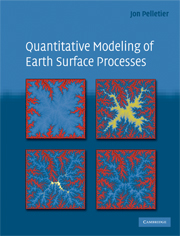
-
Select format
-
- Publisher:
- Cambridge University Press
- Publication date:
- 05 June 2012
- 07 August 2008
- ISBN:
- 9780511813849
- 9780521855976
- Dimensions:
- (246 x 189 mm)
- Weight & Pages:
- 0.84kg, 304 Pages
- Dimensions:
- Weight & Pages:
You may already have access via personal or institutional login
Book description
This textbook describes some of the most effective and straightforward quantitative techniques for modeling Earth surface processes. By emphasizing a core set of equations and solution techniques, the book presents state-of-the-art models currently employed in Earth surface process research, as well as a set of simple but practical research tools. Detailed case studies demonstrate application of the methods to a wide variety of processes including hillslope, fluvial, aeolian, glacial, tectonic, and climatic systems. Exercises at the end of each chapter begin with simple calculations and then progress to more sophisticated problems that require computer programming. All the necessary computer codes are available online at www.cambridge.org/9780521855976. Assuming some knowledge of calculus and basic programming experience, this quantitative textbook is designed for advanced geomorphology courses and as a reference book for professional researchers in Earth and planetary science looking for a quantitative approach to Earth surface processes.
Reviews
‘Revolutionary! A new powerful instrument for the study of the Earth’s surface that will change the intellectual landscape of this discipline. Rigorous and engaging, this book will train a new generation of scientists in the tools and techniques of quantitative surface processes. Indispensable for anyone interested in process geomorphology from a modern point of view.’
Sergio Fagherazzi - Boston University
'… the strength of Pelletier's book is on demonstrating practical techniques to solve classic geomorphic problems. … The style of writing is at times almost avuncular, guiding the reader through a series of computationally efficient techniques to solve basic problems. … There are typically about five exercises at the end of each chapter to test one's knowledge of the programming techniques discussed. The questions are practical, interesting and well chosen, and answers build up incrementally. … a vital resource for any student or researcher interested in earth surface processes.'
Source: Area
'Jon Pelletier has authored a surprisingly detailed textbook which describes some of the most important, or, as he writes in the introduction, most effective and straightforward quantitative techniques for modeling Earth surface processes … the book provides its own refreshing trajectory … This particular path through the different realms of geomorphology provides the reader [with] a direct route through sophisticated ways [of] modeling Earth surface processes.'
Source: Zeitschrift für Geomorphologie
Contents
Metrics
Altmetric attention score
Full text views
Full text views help Loading metrics...
Loading metrics...
* Views captured on Cambridge Core between #date#. This data will be updated every 24 hours.
Usage data cannot currently be displayed.
Accessibility standard: Unknown
Why this information is here
This section outlines the accessibility features of this content - including support for screen readers, full keyboard navigation and high-contrast display options. This may not be relevant for you.
Accessibility Information
Accessibility compliance for the PDF of this book is currently unknown and may be updated in the future.


